NCERT Solutions for Class 11 Biology Chapter 7 - Structural Organisation in Animals
The NCERT Solutions for Class 11 Biology Chapter 7 Structural Organisation in Animals explain the structure of different animals. This chapter mainly focuses on the working of the organ systems of the frog, including the digestive system, respiratory system, excretory system, and reproductive system. Well-labeled diagrams of all the organ systems are also added. Following the NCERT solutions, students can answer the difficult questions with ease during exams.
This Story also Contains
- Download Structural Organisation in Animals Class 11 Questions and Answers PDF
- Access Class 11 Biology Chapter 7 Structural Organisation in Animals Question Answer
- Class 11 Biology Structural Organisation in Animals(Practice Questions)
- Approach to Solve Structural Organisation in Animals Class 11 Question Answer
- Important Questions of NCERT Class 11 Biology Chapter 7 Structural Organisation in Animals
- What Students Learn from Structural Organisation in Animals NCERT Solutions
- Why Class 11 Biology Chapter 7 Structural Organisation in Animals NCERT Solutions are Important?
- What Extra Should Students Study Beyond the NCERT for NEET?
- NCERT Solutions for Class 11 Biology - Chapter Wise
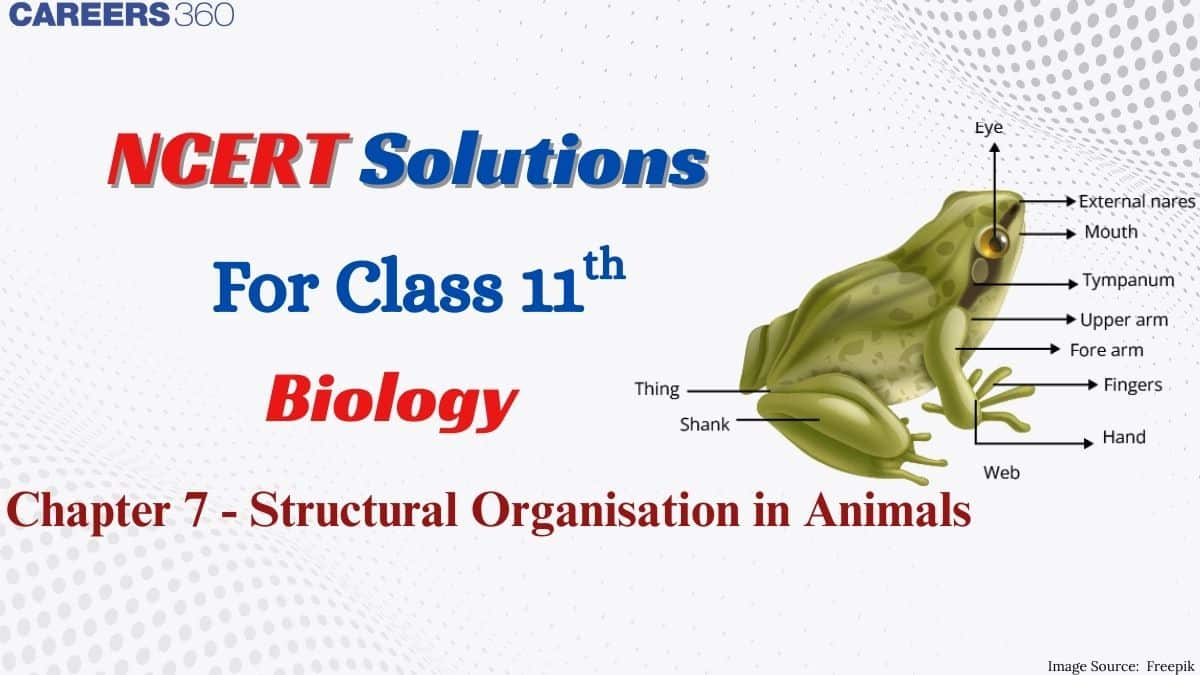
Structural Organisation in Animals Class 11 question answer discusses the external and internal structure of animals in simple and clear language. Students will also understand how different organ systems work together to perform specific functions. Structural Organisation in Animals Class 11 questions and answers PDF provides a detailed set of questions to help students revise key concepts easily. By using the NCERT Solutions Class 11, learners can strengthen their understanding and improve their performance in school exams as well as competitive exams like NEET.
Download Structural Organisation in Animals Class 11 Questions and Answers PDF
Students can access the PDF from the link given below. Structural Organisation in Animals Class 11 questions and answers PDF can be used offline anytime, anywhere, without needing the internet. The solutions are prepared according to the latest NCERT curriculum to help students understand the topic clearly.
Also Read,
Access Class 11 Biology Chapter 7 Structural Organisation in Animals Question Answer
Given below are the detailed answers to all the textbook questions. This helps students understand how animals are organised, from tissues to organs. Practicing the Class 11 Biology Chapter 7 Structural Organisation in Animals question answer improves problem-solving skills.
Q1. Draw a neat diagram of the digestive system of a frog.
Answer:
The diagram of the digestive system of a frog is given below.
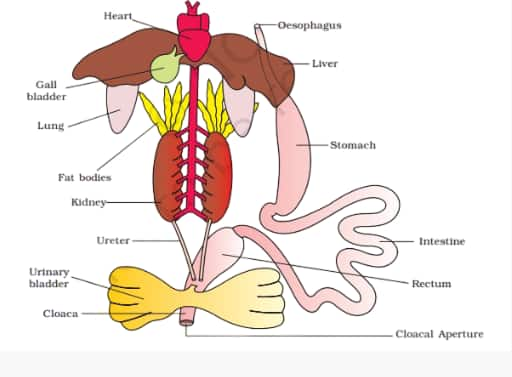
Q2. Mention the function of the ureters in frogs.
Answer:
In frogs, ureters are tubes that carry urine from the kidneys to the cloaca.
- Male Frogs: The ureters carry urine from the kidneys and also transport sperm from the testes to the cloaca.
- Female Frogs: The ureters carry only urine from the kidneys to the cloaca. Eggs from the ovaries move to the cloaca separately.
Class 11 Biology Structural Organisation in Animals(Practice Questions)
Q.1. Describe the external features of a frog, including its skin, limbs, and eyes.
Answer:
Frogs' skin is smooth, moist, and slimy due to mucus secretion, which helps them in respiration and camouflage. The animal has 2 pairs of limbs, with hindlimbs being long and muscular for jumping and swimming, while the forelimbs help to maintain balance. Their eyes are large, bulging, and have a nictitating membrane utilised for protection and vision. Their eyes are positioned on the sides of the head, which gives them a wide field of view and helps in swallowing food.
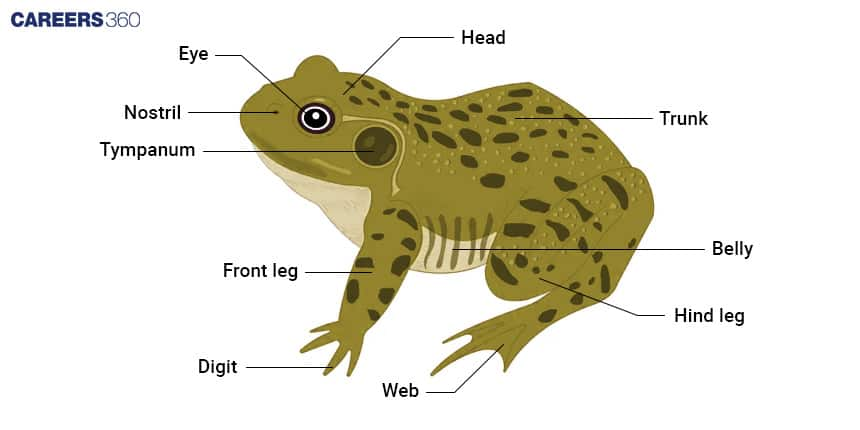
Q.2. Explain the different types of respiration in frogs, including cutaneous, pulmonary, and buccopharyngeal respiration.
Answer:
Frogs can perform three different types of respiration: cutaneous, pulmonary, and buccopharyngeal. Cutaneous respiration occurs through the moist skin, which allows gas exchange in both water and air. Pulmonary respiration can occur with the help of the lungs for breathing on land. Buccopharyngeal respiration can occur through the moist lining of the buccal cavity, helping gas exchange when the mouth is closed underwater.
Q.3. Compare and contrast the male and female frog reproductive systems, including the presence of vocal sacs and copulatory pads.
Answer:
Male and female frogs have distinctive reproductive features. Males have vocal sacs, which can amplify mating calls. The copulatory pads on their forelimbs help in gripping the female during copulation. Females do not have either of them but have larger ovaries that produce eggs. Both sexes have paired gonads, where males produce sperm while females produce eggs for external fertilization.
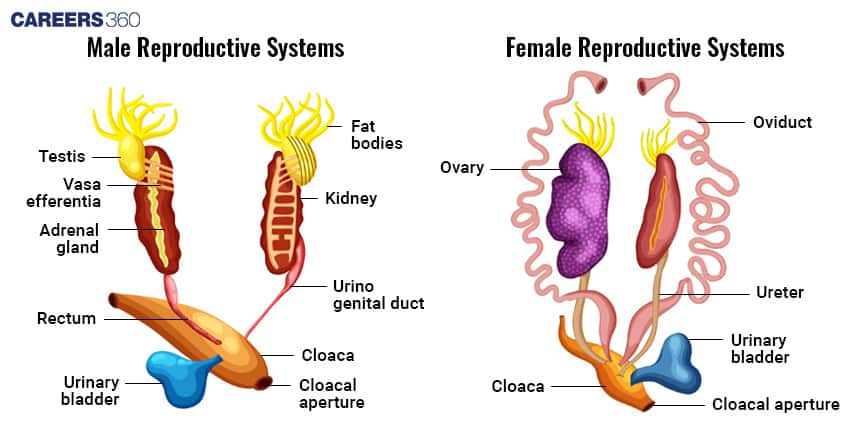
Q.4. Discuss the functions of the frog's heart and circulatory system.
Answer:
Frogs have a three-chambered heart, having two atria and one ventricle, which helps them to separate oxygenated and deoxygenated blood. They perform double circulation, which means blood passes through the heart twice in one complete cycle. These circulations help transport oxygen, nutrients, and waste throughout the body. Frogs oxygenate their tissues by doing both aquatic and terrestrial respiration.
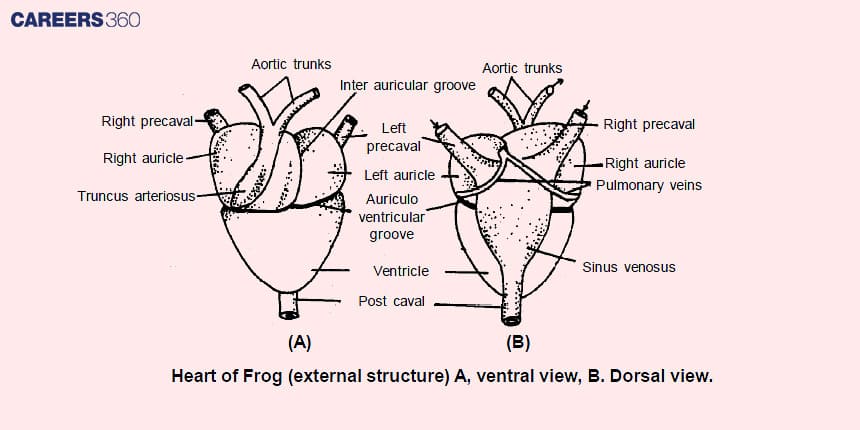
Q.5. Explain the adaptations of the frog's digestive system for a carnivorous diet.
Answer:
Frogs have a short digestive system adapted well for their carnivorous diet, which consists of insects and small invertebrates. Their tongue is long, sticky, and attached at the front, which allows them to catch prey. Their teeth help grip food, and digestion begins in the stomach, where the enzymes break down proteins. A short intestine allows the absorption of nutrients, and the liver produces bile to help in fat digestion. The cloaca finally helps in excreting waste efficiently.
NCERT Solutions for Class 11: Subject-wise
Approach to Solve Structural Organisation in Animals Class 11 Question Answer
A few points are listed below, which students can follow to solve questions effectively from this chapter.
- Students need to learn the digestive, respiratory, and circulatory systems of a frog. They can prepare flowcharts to remember the sequence of organs.
Try to focus on diagrams and labeling in frog anatomy, as they are asked in the exam. All diagrams are included in the Class 11 Biology Chapter 7 Structural Organisation in Animals question answer.
Practice by writing short and clear answers for topics like morphology and the nervous system.
Go through the Class 11 Biology Structural Organisation in Animals question answer line by line. Revise each topic thoroughly before the exams.
Solve previous years' questions and refer to the NCERT Solutions Class 11 Biology to understand how questions are framed in the exam.
Also, check the NCERT Books and NCERT Syllabus here:
Important Questions of NCERT Class 11 Biology Chapter 7 Structural Organisation in Animals
Provided below is an important question from this chapter, along with the answer. To gain clarity about the concepts, it is important to solve questions. For this purpose, students can refer to the NCERT Solutions for Class 11 Biology Chapter 7 Structural Organisation in Animals.
Question 1: What role does the glottis play in frog respiration?
1. It allows for the entry of air into the lungs.
2. It controls the opening and closing of the nostrils.
3. It aids in vocalization and sound production.
4. It helps in the regulation of body temperature.
Answer:
The glottis is a small opening located at the back of the oral cavity in frogs. It serves as the entrance to the respiratory system. When a frog breathes, the glottis opens, allowing air to enter the lungs. This air passes through the buccal cavity, where gas exchange occurs across the moist lining, and then continues into the lungs for further gas exchange. After oxygen is extracted from the air in the lungs, carbon dioxide is expelled from the body through the same pathway. So, the glottis plays a crucial role in facilitating the entry of air into the frog's lungs, enabling respiration to occur.
Hence, the correct answer is option 1), It allows for the entry of air into the lungs.
Question 2: When the heart of a frog is removed from its body, it continues to beat for a certain period of time. Which of the following statements best explains this phenomenon?
1. The heart of a frog is autoexcitable.
2. Frogs are poikilothermic animals.
3. Frogs lack coronary circulation.
4. The heart of a frog is myogenic in nature.
Select the most appropriate option from the above statements.
Options:
- Only option 1 is correct
- Options 2 and 3 are correct
- Options 3 and 4 are correct
- Only option 4 is correct
Answer:
The phenomenon of a frog's heart continuing to beat after being removed from the body can be explained by two statements:
Statement 3: The heart is "myogenic" in nature, meaning it can generate its electrical impulses for contraction without external stimulation.
Statement 4: The heart is auto-excitable, which means it has the inherent ability to produce its electrical activity.
Both statements support the observation that a frog's heart can sustain its beating even when isolated from the body.
Hence, the correct answer is option C). Options 3 and 4 are correct
Question 3:
Assertion: The third cleavage in frogs follows a latitudinal pattern.
Reason: The orientation of the mitotic spindle is parallel to the polar axis.
Options:
- Both the assertion and reason are true, and the reason is a correct explanation of the assertion.
- Both the assertion and reason are true, but the reason is not a correct explanation of the assertion.
- The assertion is true, but the reason is false.
- Both the assertion and reason are false.
Answer:
The third cleavage in frog embryos is indeed latitudinal, dividing the blastomeres horizontally. However, the mitotic spindle during this cleavage is oriented perpendicular to the polar axis, not parallel. Hence, the assertion is true, but the reason is false.
Hence, the correct answer is option C) Both the assertion and reason are true, but the reason is not a correct explanation of the assertion.
Question 4: Which one of the following types of cells is involved in making the inner walls of the large blood vessels?
1. Stratified epithelium
2. Squamous epithelium
3. Columnar epithelium
4. Simple columnar epithelium
Answer:
Inner surfaces of large blood vessels, including arteries and veins, as well as various internal organs, are lined with squamous epithelium, characterized by its thin, flat cellular structure. This type of epithelium provides a smooth, low-friction surface that minimizes resistance and facilitates efficient blood circulation.
Hence, the correct answer is option 2). Squamous epithelium
Question 5: Choose the accurate route for the passage of sperm in the male frog:
1. Testes → Vasa efferentia → Kidney →Seminal vesicle →Urinogenital duct → Cloaca
2. Testes → Vasa efferentia → Bidder's canal → Ureter → Cloaca
3. Testes → Vasa efferentia → Kidney → Bidder's canal → Urinogenital duct → Cloaca
4. Testes → Bidder's canal → Kidney → Vasa efferentia → Urinogenital duct → Cloaca
Answer:
In male frogs, sperm produced in the testes pass through the vasa efferentia into the kidney, then enter Bidder’s canal, which connects to the urinogenital duct, and finally reach the cloaca for excretion. This route ensures that sperm mixes with urine and is carried out efficiently during reproduction.
Hence, the correct answer is option 3) Testes → Vasa efferentia → Kidney → Bidder's canal → Urinogenital duct → Cloaca
Question 6: During hibernation, frogs rely mainly on which organ for the storage of reserve food?
1. Liver
2. Kidneys
3. Lungs
4. Pancreas
Answer:
During hibernation, frogs depend on stored glycogen and fat for survival. The liver is the primary organ where these reserve nutrients are stored in large quantities. This stored glycogen is gradually broken down to supply energy during the long period of inactivity.
Hence, the correct answer is option 1) Liver
Question 7: In frogs, which structure prevents the entry of food into the windpipe during swallowing?
1. Glottis
2. Epiglottis
3. Buccal cavity
4. Oesophagus
Answer:
Frogs do not possess a true epiglottis like mammals. Instead, the glottis closes during swallowing to prevent food from entering the respiratory pathway. This ensures that food is properly directed into the oesophagus and prevents choking.
Hence, the correct answer is option 1) Glottis
What Students Learn from Structural Organisation in Animals NCERT Solutions
Animals have complex bodies made up of many specialized parts that perform different functions. This chapter helps students learn important concepts, which are given below:
Students understand the different types of tissues, including epithelial, connective, muscular, and nervous tissues, and their functions.
Learners also know how systems like the digestive, circulatory, excretory, and nervous systems are organised in animals.
They explore the anatomy of animals like the frog through the Class 11 Biology Structural Organisation in Animals question answer.
Students also gain clarity on how organ systems work together to perform different functions in the body.
Why Class 11 Biology Chapter 7 Structural Organisation in Animals NCERT Solutions are Important?
The chapter Structural Organisation in Animals helps students understand the organisation of the animal body at different levels, from cells to tissues, organs, and organ systems. The solutions mainly focus on the organisation of the frog, along with well-labeled diagrams.
- Class 11 Biology Chapter 7 Structural Organisation in Animals NCERT Solutions make students understand the difference between simple and complex tissues.
- The solutions also explain the structure and working of the digestive, circulatory, excretory, and reproductive systems of the frog, along with diagrams.
- Students will understand how animals adapt to their surroundings and survive in environmental conditions using the solutions.
- They also gain knowledge on the organ system coordination and function, about which questions are frequently asked in the NEET exam. This makes the solutions an important and valuable resource for students.
What Extra Should Students Study Beyond the NCERT for NEET?
Below is a table showing the important topics students should study beyond the NCERT. These topics match their preparation with the NEET syllabus. Referring to the NCERT Solutions for Class 11 Biology Chapter 7 Structural Organisation in Animals supports overall understanding.
NCERT Solutions for Class 11 Biology - Chapter Wise
Explore detailed, chapter-wise answers to help you understand concepts clearly and strengthen your biology fundamentals.
Frequently Asked Questions (FAQs)
According to the NCERT Solutions for Class 11 Biology Chapter 7 Structural Organisation in Animals, there are 4 major types of tissue: Epithelial tissue, connective tissue, muscular tissue, and nervous tissue.
- NCERT Solutions Class 11 Biology Chapter 7 Structural Organisation in Animals will also help you with competitive exams like NEET.
- These solutions will also boost your knowledge.
- To score well in the examination, follow the NCERT syllabus and solve the questions given in the NCERT Exemplar.
The important topics included in the NCERT Solutions for Class 11 Biology Chapter 7 Structural Organisation in Animals are morphology and anatomy of frogs.
In Class 11 Biology Chapter 7, the main focus is on frog anatomy. Here, we learn about the structural organization of the frog, including its tissues, organs, and body systems, focusing on the nervous, circulatory, digestive, and reproductive systems.
Connective tissue supports connecting or separating other tissues or organs of the body. They are the most abundant tissue types such as bone, blood and cartilage.
Epithelial tissues are grouped by cell shape and tissue layers and perform many functions like protection, absorption, secretion, and filtration. The main epithelial tissue types include simple squamous, cuboidal, and columnar, with stratified and pseudostratified variations designed for different sites and functions.
In Class 11 Biology Chapter 7, the main focus is on frog anatomy. Here, we learn about the structural organization of the frog, including its tissues, organs, and body systems, focusing on the nervous, circulatory, digestive, and reproductive systems.
Muscular tissue in animals is important for the movement of the organism. The tissue system allows organisms to interact with their environment and perform various bodily functions through the contraction and relaxation of specialized cells called muscle fibers.
Courses After 12th
Applications for Admissions are open.
As per latest syllabus. Physics formulas, equations, & laws of class 11 & 12th chapters
JEE Main Important Chemistry formulas
Get nowAs per latest syllabus. Chemistry formulas, equations, & laws of class 11 & 12th chapters
JEE Main high scoring chapters and topics
Get nowAs per latest 2024 syllabus. Study 40% syllabus and score upto 100% marks in JEE
JEE Main Important Mathematics Formulas
Get nowAs per latest syllabus. Maths formulas, equations, & theorems of class 11 & 12th chapters
